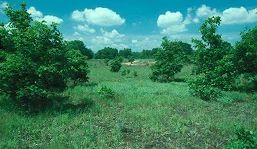Blue River Sand Barrens
No. 69

Photo by Thomas A. Meyer/DNR
Blue River Sand Barrens features one of Wisconsin's largest and best examples of this harsh and arid ecological community. Sand barrens are upland communities that develop on unstable alluvial sands along rivers such as the Mississippi and Wisconsin. They are partly or perhaps wholly anthropogenic in origin, occurring on sites historically disturbed by plowing or grazing. The flat, sandy areas resemble dry prairies but contain actively moving sand dunes, which are stabilized by a thin forest cover of black and Hill's oak. "Blowouts," large, unvegetated depressions in the sand surface eroded by wind, are scattered throughout. Early dune and blowout colonizers include lichens, false heather, bearberry and sedges while species such as three-awn grass, June grass, rough blazing-star, hoary puccoon, sand cress and prickly pear cactus are common in the barrens. Invertebrate life includes unusual species and an abundance of ant lions. Additional animal life includes vesper sparrow, Franklin's ground squirrel and numerous nocturnal rodents. The DNR owns Blue River Sand Barrens, designated a State Natural Area in 1968.
Very few State Natural Areas have public facilities, but nearly all are open for a variety of recreational activities, as indicated below. Generally, there are no picnic areas, restrooms, or other developments. Parking lots or designated parking areas are noted on individual SNA pages and maps. Trails, if present, are typically undesignated footpaths. If a developed trail is present, it will usually be noted on the SNA map under the Maps tab. A compass, topographic map, or GPS unit are useful tools for exploring larger, isolated SNAs.
The majority of SNAs are isolated and have few or no facilities. Some SNAs have vehicle access lanes or parking lots, but their accessibility may vary depending on weather conditions. Parking lots and lanes are not plowed during winter. Hiking trails may be nonexistent or consist of undeveloped footpaths. A GPS unit or compass and a detailed topographic map are valuable tools for exploring larger SNAs.
Entrance fees: Except for Parfrey's Glen, Pewit's Nest, The Dells of the Wisconsin River, SNAs within State Parks and some within State Forests, all other DNR-owned SNAs do not have any admission fees. For more information, see Wis. Admin. Code NR 45. For non-DNR-owned SNAs, we are unaware of any vehicle or admission fees. However, please get in touch with the landowner for more information.
Allowable activities: DNR-owned land
The activities listed below are generally allowed on all DNR-owned SNA lands. Exceptions to this list of public uses, such as SNAs closed to hunting, are noted above and posted with signs on the property site.
- Hiking
- Fishing
- Cross country skiing
- Hunting
- Trapping
- Scientific research (permit required)
- Outdoor education
- Wild edibles (What is this?)
- Pets (Rules)
- Wildlife viewing
Prohibited activities: all SNAs
- Camping and campfires
- Collecting of animals (other than legally harvested species), non-edible fungi, rocks, minerals, fossils, archaeological artifacts, soil, downed wood, or any other natural material alive or dead.
- Collecting for scientific research requires a permit issued by the DNR
- Collecting of plants including seeds, roots or other non-edible parts of herbaceous plants such as wildflowers or grasses
- Geocaching
- Horseback riding
- Rock climbing
- Vehicles, including bicycles, ATVs, aircraft, and snowmobiles except on trails and roadways designated for their use.
For rules governing state-owned SNAs and other state lands, please consult Chapter NR 45 Wis. Admin. Code [exit DNR].
Location
Within the Lower Wisconsin State Riverway, Grant County. T8N-R1W, Section 6 SE¼. 129 acres.
Driving directions
From the intersection of State Highway 133 and County Highway T in Blue River, go east on State Highway 133 1.9 miles, then north on Wightman Road 0.25 miles to the southeast corner of the area. Park along the road.
The DNR's state natural areas program comprises lands owned by the state, private conservation organizations, municipalities, other governmental agencies, educational institutions, and private individuals. While most SNAs are open to the public, access may vary according to individual ownership policies. Public use restrictions may apply to protect public safety or endangered or threatened species or unique natural features. Lands may be temporarily closed due to specific management activities.
Users are encouraged to contact the landowner for more specific details. The data on these maps have been obtained from various sources of varying age, reliability, and resolution. The data may contain errors or omissions and should not be interpreted as a legal representation of legal ownership boundaries. To create your custom map, which allows you to zoom to a specific location, please use the DNR's Mapping Application.
Wisconsin DNR owns Blue River Sand Barrens
